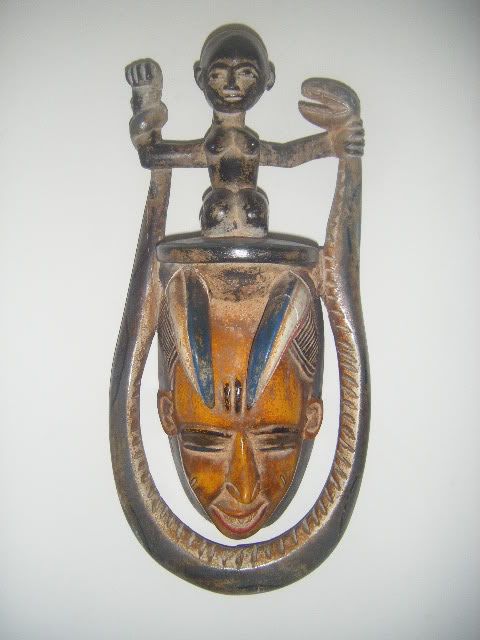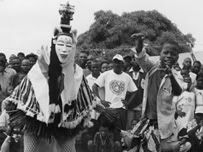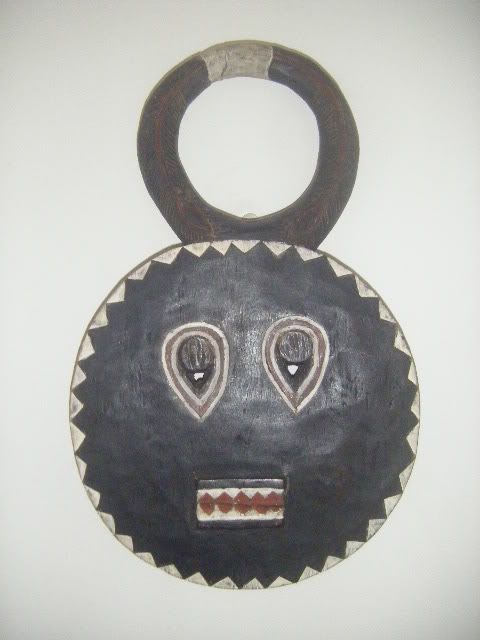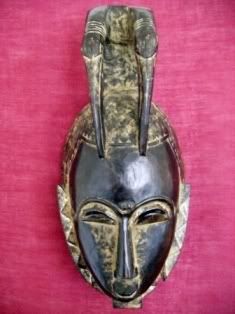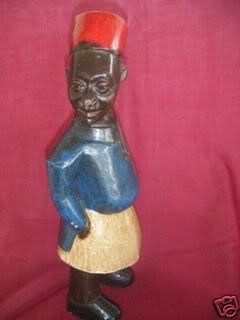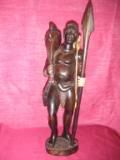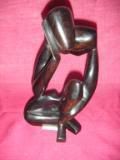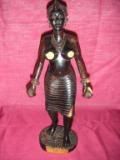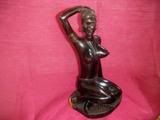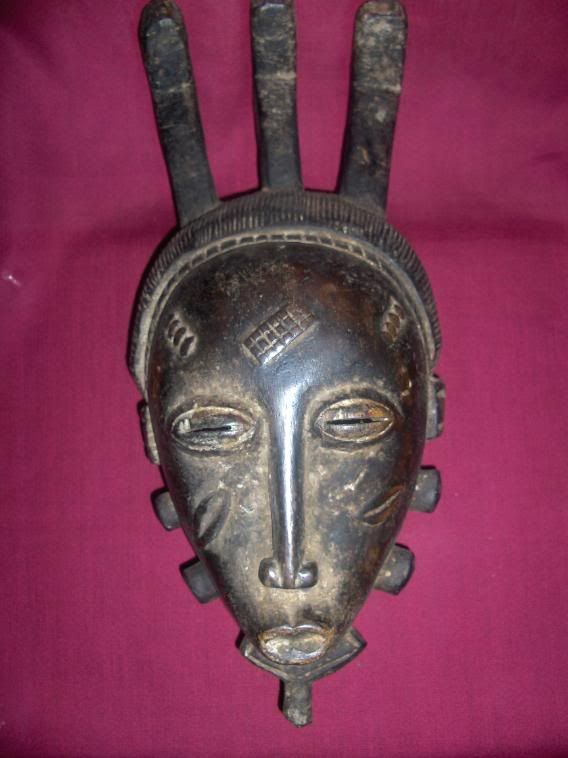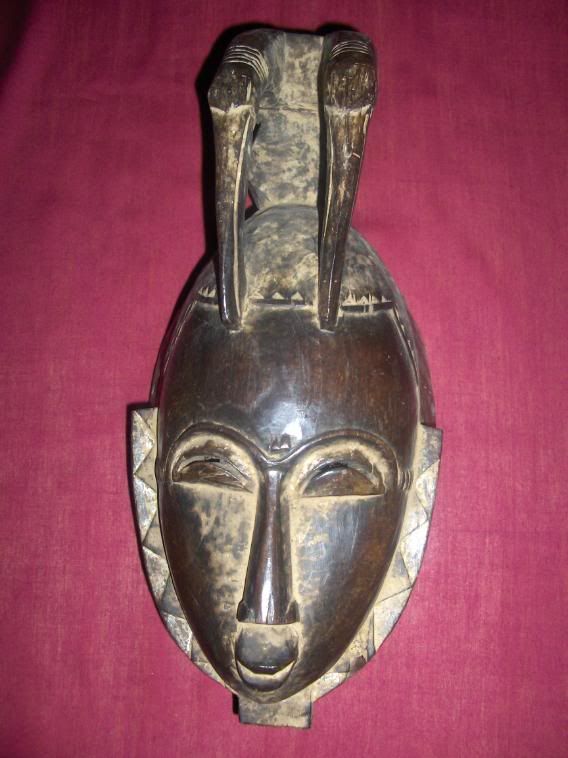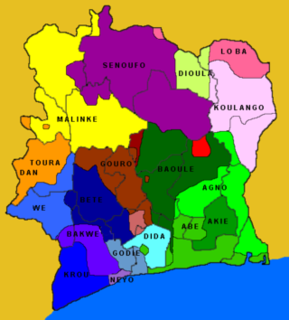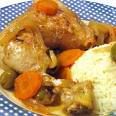Sunday, November 30, 2008
African famous quote ( part 2)
Don’t insult the crocodile until you cross the water.
It means be careful when you critize others
Only a knife knows what the inside of a coco-yam looks like.
It means that the person who investigate and research something understand the subject.
A big blanket encourages sleeping in the morning.
It means that luxury encourages idleness. If you have worked hard and made wise choices, you will
find contentment.
A bird that is eating guinea-corn keeps quiet.
It means that you should dedicate yourself to a task.
Rats don’t dance in the cat’s doorway.
It means that you should not look for trouble.
A hippopotamus can be made invisible in dark water.
It means that it is important to be informed and alert. Ignorance can lead to danger.
If your house is burning, there is not time to go hunting.
It means that it is important to make priorities.
Don’t forget that you can purchase African art if you visit the following links below:
http://ie.four.ebid.net/stores/myafrikart
http://myworld.ebay.ie/whatagwanagal/
Sunday, November 23, 2008
African art: Zaouly ( Zaouli) mask
Zaouly mask is a symbol of the Gouro community in Ivory Coast.
It is said that Djela Lou Zaouly was a goddess for the Gouro people. The Gouro word “ Djela Lou Zaouly” means “ The lion’s daughter”.Zaouly is a goddess for beauty.
You can purchase a Zaouly mask if you visit one of the following links:
http://ie.four.ebid.net/stores/myafrikart
http://myworld.ebay.ie/whatagwanagal/
Zaouly masks have always bright colours . They can be used for ceremonies and also in funerals. They are always associated with a special stylish dance . You can see the dance if you visit the following links:
http://www.youtube.com/watch?v=Ve_O9L4RS0I
http://www.youtube.com/watch?v=3M5GVwXb2XY
Saturday, November 22, 2008
Ebay versus Ebid
A quick note to inform you that My Afrik’Art is currently testing a new auction platform called Ebid.
You can see our listing if you visit the following link:
http://ie.four.ebid.net/stores/myafrikart
The main advantage of Ebid is the fact that the insertion fees are minimum or even inexistant compare to Ebay. Therefore you don’t have to pay if your item does not sell. It seems fair compare to Ebay which is charging you a lot of money and does not help you bring more traffic to your auction ( for instance changing the way their search engine works does not help a lot of sellers). Ebay became too big and they forgot to stay human. Ebay customer service is very bad and most of the time when you contact them for an issue, they don’t even bother to answer you.
Therefore I invite everybody who is currently Ebay addict or fan to have a look at ebid and see by yourself.
Happy bidding…
Wednesday, November 19, 2008
African mask - Kple Kple mask
The Kple Kple mask is from the Baoule community in Ivory Coast.
The face refers to the sun, and the sunbeams are represented by polychromed triangles.This type of mask is usually used in commemorative, agricultural and burial ceremonies. The mask would generally be worn with a raffia (grass) costume attached to the lower section of the mask reaching to below the waist with a grass skirt and other grasses covering the body and legs.
Below you will see an image of a ceremony when the Kple Kple mask was used.
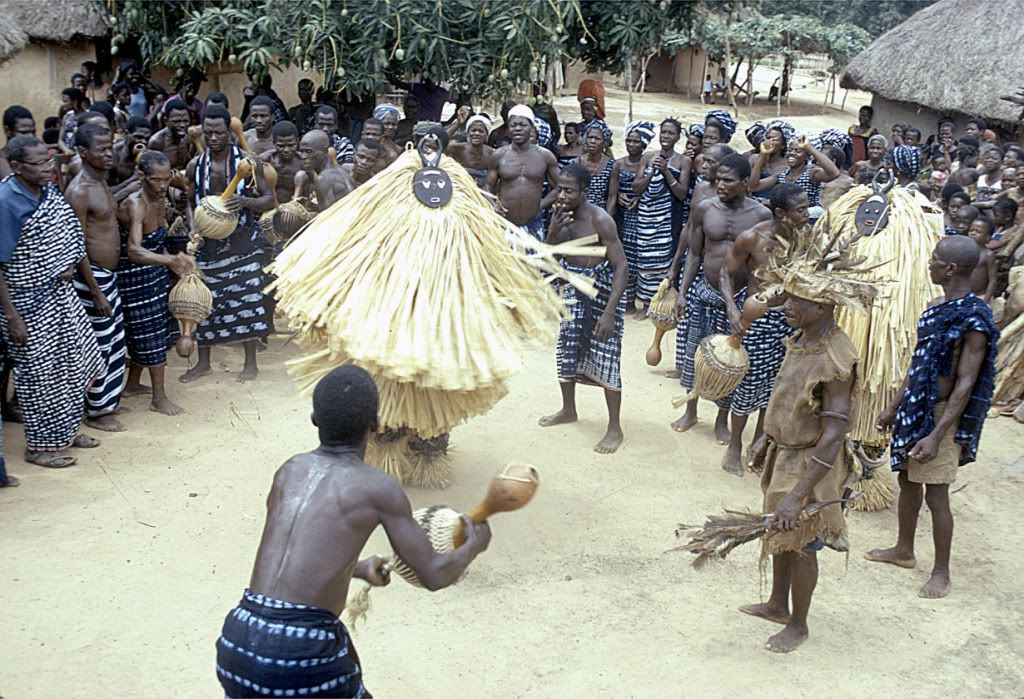
Baule masked dancers of the Goli society, Kondeyaokro village, Côte d’Ivoire. Photograph by Eliot Elisofon, 1972
You can purchase this type of mask if you visit the following link before the 2nd of December. It could be a nice present to add an exotic touch in some of your relatives house or even if your house during the winter time:
http://myworld.ebay.ie/whatagwanagal/
Sunday, July 27, 2008
African art ( part 2): African art and craft seen with new eyes
It is important to know that African art went through different status over the last centuries. Of course, all the different status were always set by the Westerner people:
-XVth-XVIIIth century: African art = curiosity
While the Portuguese are the first to arrive in Black Africa , they try to impose the christianity to African people and they burn any wood art created by the inhabitants for their rituals. However Portuguese have a growing interest for ivory and gold. So to sum up during this period, all the ritual and sacred objects are encountering a negative judgment from the Portuguese and the other objects ( objects made of ivory for instance) are judged using Westerner criteria and they are brought back to Europe to be shown in what is called “ curiosity” chambers. These special chambers were successful until the XVIIIth century. The main goals of these chambers are to entertain, fascinate and teach.
-XIXth century: From curiosity to scientific objects
At the end of the XIXth century, the westerner expeditions changed and scientists are now part of them. Slowly the “curiosity chambers” became museums. The objects placed in museums are now used for ethnographic specimen and they are the witnesses of civilization progress. During this period, the objects are only studies by ethnologists and never by art historians. In the last 25 years of the XIXth century, colonialism is fully part of the Westerner strategies and universal exhibitions show African objects and also humans. African people are brought back to Europe to be put in museums so that westerner people can see how it is to live in Africa.
-XXth century : From scientific objects to primitive arts
Primitive arts appeared since the middle of the XIXth century but at this period, the expression “ primitive arts” means that it was created by people in the first period of evolution. A lot of Westerner artists had an interest for African objects but they only look at them from an aesthetic point of view.
-Today : An art fully recognized but still not fully understood by a lot of persons
Since 1960, primitive art has a growing public. For instance the Branly museum opened in 2005.
You can discover African art by visiting the following website: http://www.myafrikart.com
Thursday, July 10, 2008
The Baoulé tribe
The Baoulé originally come from Ghana and they were lead to Cote d’Ivoire by Queen Abla Pokou. I wrote an earlier note in relation to Queen Abla Pokou. Their name come from the legend in relation to the Queen Abla Pokou and “baouli” means “ the child is dead”.
One of the former president of Cote d’Ivoire named Houphouët-Boigny was part of the Baoulé tribe.
The Baoulé as a lot of ethnic tribes in Ivory Coast have their own dance:
-Goly dance
- Adjemele dance
-Adjos dance
- Kotou dance
The Baoulé are famous sculptors, weaver and goldsmith.
The Baoulé believe in a creator God. Their God controls men and animals. Spirits have supernatural powers. The real world is the opposite of the spiritual world where souls come from at birth and go back at death. Their belief is founded around the death and the immortality of the soul. The Baoule do ancestors workship but ancestors are not represented.
In the Baoule culture, sculptures and masks allows them to be in contact with the spiritual world. Baoule traditional masks are always wore by the men. Traditional masks corresponds to 3 types of dances/events
- Gba gba: originally from the Guro tribe, this mask is used for women funerals during the harvest seasons. It celebrates beauty.
- Bonu amuen: it protects the village from outside threats. It appears during the death of notable people.
- Goli: this mask has a rounded form and two horns. It celebrates peace and happiness.
In contrary to other ethnic groups, the sculptors skills are not passed over from father to son. It results from a personal choice.
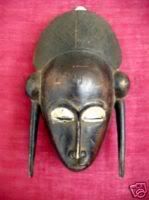
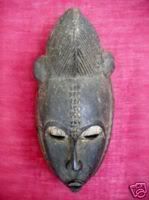
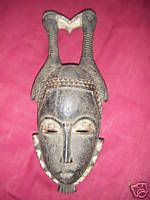
You can see more masks if you visit : http://www.myafrikart.com
Sunday, June 29, 2008
Senufo group and the secret society: Poro
The Senoufo have a very interesting political system. It is a matrilineage society. They are four societies which educate and governs the Senufo: Poro, Sandogo, Wambele and Tyepka.We will mainly speak about the Poro society today.
The Poro society is reserved for men ( but it is good to know that apparently young girls and postmenopausal women are permitted to join) and it is a secret society. The main purpose of the Poro society is to guarantee a good relationship between the living world and the ancestors. They are responsible for the religious traditions, ceremonies and also for maintaining the order between the people.
When men are part of the Poro society, they have to go through 3 different phases of 7 years each. It generally starts when the boy are 7 years old and end when they are 28 years old. During the induction, the young men converse with each other using a secret language known only to other Poro members .
It is important to know that in the Senufo culture, when a man is born, it is only an animal and the Poro will help them to change their status.
The different phases can be broken down to:
- The “Kouord”: children are given special tasks and also learn special symbolic words.
- The “dain”: it teaches teenagers how to live in community .During this period, the teenagers are asked to make personal sacrifices. They are taught how to participate in rituals, how to prepare the ritual clothes,etc.
- The “Tcholo”: it helps in understanding the meaning of life. The elders will reveal some secrets that young men were not able to understand until this period. Young men will be taught about philosophy, social behaviours and a professional skill.
- The “Kaffono”: this gives the supreme knowledge and the final sacrament.
Once initiate, the men need to give an annual contribution. In exchange, they will receive support from the elders, they are also protected by the masters and after their death, their funerals are organized by the Poro members.
All the initiatory ceremonies are happening in a sacred wood outside of the villages. This place is considered as the propriety of Katyéléo ( The Senufo goddess).
.The Senufo produce a rich variety of sculptures, mainly associated with the poro society. The sculptors and metalsmiths, endogamous groups responsible for making the cult objects live on their own in a separate part of the village.
You can find Senoufo statues and masks if you go to : http://www.myafrikart.com
Friday, June 20, 2008
Guro tribe and Guro traditional masks
It is said that the Guro people contrary to other tribes do not have a chief. They are governed and regulated by a concil of elders and each main family of the village has a representation on the council.
The daily life of the Guro is dominated by secret societies and by a belief in protective spirits called “Zuzu”.
The Guru are well known for their artistic sense. While carving their masks, the Guru often combine the human and animal forms. In addition, the masks are normally almond shaped eyes rounded forehead,
You can see below a picture of a Guro mask:
You can learn more about this mask and purchase other authentic masks if you visit:
http://www.myafrikart.comhttp://stores.ebay.ie/My-AfrikArt
Sunday, June 15, 2008
Tribute to Senegalese tirailleurs ( Skirmisher - sharpshooter)
Since the XVII century, French used African people to fight for them.
However it is in 1857 that the black troops have been officially created and named “ Senegalese tirailleurs”. “Tirailleur” means sharpshooter in French. It is a term used to designate the troops trained to skirmish ahead of the columns. These troops are called “Senegalese tirailleurs” but you have to know that they were not only formed of Senegalese people. All together they gather 17 African nationalities such as soldiers from Sudan, Guinea, Tchad, Algeria,etc.
These troops not only help France in the various colonial campaigns but also during World War I and World War II. The Tirailleurs always fought with distinction and incurred heavy losses.
It happens that one of the mosque of Paris was constructed after World War I as a sign of gratefulness from France to the Muslims soldiers. In addition, some famous political leaders also recognized these brave troops in speeches. For instance, Marechal Foch said :
«J'ai admiré leur merveilleux courage, leur indomptable ténacité, leur élan fougueux. .. J'ai apprécié leur profonde loyauté et leur absolu dévouement».”
which means
« I admired their guts and bravery,indomitable single-mindedness, spirited momentum, I appreciated their loyalty and their full devotion.”
Most of the Tirailleur troops have been disbanded during the independence of African countries between 1956 and 1962. These former soldiers have always been discriminated despite their loyalty compare to the French soldiers. It is only in 2006, after 60 years that Jacques Chirac finally decided to increase the pensions of former colonial soldiers.
I advise you to watch the movie “Indigènes” or “ Days of Glory” ( English title) directed by French-Algerian Rachid Bouchareb.
Finally, you can purchase an authentic statue of a Senegalese Tirailleur made during the colonial period if you click the link below:
http://stores.ebay.ie/My-AfrikArt
You can also find it if you go to: http://www.myafrikart.com
Tuesday, June 10, 2008
African art ( part 1)
Then, during the colonialism period, as the European colonizer considered African population as being a primitive population, therefore they did not show any interest for African art.
It is only in the XX century that African art is really started to be appreciated from European population. For instance, in 1905, Maurice de Vlamnick ( a French painter) bought a pair of statues in a bar and then, Picasso, Matisse and other famous painters started to collect African art. It greatly impacted some of their masterpieces.
It is also important to mention that in many occasion art production is related to ritual or tribal ceremonies.For instance a mask carver creating a traditional mask can be considered as an artist but the mask is not created for decorative purpose. It is created for a ceremony or a ritual. In Africa, most of the time, the art created is not owned by the artist but it is the expression of an ethnic group, people,divinity using the craftman skills. African art reflects the history, philosophy, religion,myths, belief, culture of the vast continent.
You can discover some great and unique African art by visiting: http://www.myafrikart.com
Monday, June 2, 2008
African masks and the mask carvers
Carving a mask is a very sophisticated and complicated art. In many part of Africa, the apprentice will have to work between 3 to 7 years with the master carver in order to fully learn how to create a mask. This art is actually very often transferred from father through son through several generations.
As mentioned previously, this art is very often transferred from father through son. You have to know that mask carvers are exclusively male. I recently learnt that the carving of a ritual mask is normally done in seclusion and his preceded by a long prepration that includes fasting,abstention from sexual activity,and other purification rites.
The mask carvers is a very respected artisan. They often make their own tools. The mask created by the mask carvers are not owned by them, neither they are owned by the wearer. They are owned by the community or secret society and they are kept in a special place.
The protection of the masks is not the responsability of the mask carver. This responsability of great importance and honor is often given to a women. She is the only one allowed to see them when they are not in use.
You can see and purchase traditional African masks from the Dan ethnic tribe for instance if you go to:
http://www.myafrikart.com
Sunday, May 25, 2008
Celebration of Africa: Africa Unity
But what is the African Union?
It all started on the 25th of May 1963 when the Organisation of African Unity was created in Addis Abeba. At this time, it had 32 independent member states.
The Organisation of African Unity (OAU) had the following objectives:
1.to promote the unity and solidarity of the African States;
2. to co-ordinate and intensify their cooperation and efforts to achieve a better life for the peoples of Africa
3. to defend their sovereignty, their territorial integrity and independence
4. to eradicate all forms of colonialism from Africa; and
5. to promote international cooperation, having due regard to the Charter of the United Nations and the Universal Declaration of Human Rights.
Haile Selassie ( an Ethiopian emperor) is said to be the father of the Organization of African Unity. He played a decisive role in the convening of the summit in 1963 and the signing of the OAU charter. The Emperor Haile Selassie demonstrated throughout his life a great interest in Africa’s peace, progress and prosperity.
The well being of the African continent is in between the African Youth and it is more and more important to understand that All African countries should UNITE and stand for their rights and well being.
It is really sad to see what is currently happening in South Africa or in Darfour.
One of Heile Selassie’s speech has been set to music by Bob Marley in the song War.
In this speech Heile Selassie explained that it is crucial to stop making differences and unfortunately until that day will come, there will be war all over the world!
Here are the lyrics of the song WAR:
Until the philosophy
which hold one race Superior and another inferior
Is finally and permanently discredited and abandoned
Everywhere is war, me say war
That until there are no longer first class
And second class citizens of any nation
Until the colour of a man's skin
Is of no more significance than the colour of his eyes
Me say war
That until the basic human rights are equally
Guaranteed to all, without regard to raceDis a war
That until that day
The dream of lasting peace, world citizenship
Rule of international morality
Will remain in but a fleeting illusion
To be pursued, but never attained
Now everywhere is war, war
And until the ignoble and unhappy regimes
That hold our brothers in Angola, in Mozambique, South Africa sub-human bondage
Have been toppled, utterly destroyed
Well, everywehre is war, me say war
War in the east, war in the west
War up north, war down south
War, war, rumours of war
And until that day, the African continent
Will not know peace, we Africans will fight
We find it necessary and we know we shall win
As we are confident in the victory
Of good over evil, good over evil, good over evil
Good over evil, good over evil, good over evil
The OAU was disbanded in 2002 and replaced by the African Union. You can read more about the African Union if you go to: http://www.africa-union.org/root/au/index/index.htm
Don't forget that you can discover unique and hand-made African art if you go to:
http://stores.ebay.ie/My-AfrikArt
Saturday, May 10, 2008
Culture and religion in West Africa (part 1)
Benin, Burkina Faso, Cote d’Ivoire, Cape Verde, The Gambia, Ghana, Guinea, Guinea-Bissau, Liberia, Mali, Mauritania, Niger, Nigeria, Senegal, Sierra Leone and Togo.
There is a wide variety of cultures in all these countries but there is also a lot of similarities in term of music, cuisine, dress, religion beliefs. In West Africa, we can find Islam ( specially in the interior and far west coast), christianity , animism.
We are all more or less familiar with Islam and Christianity.
However animism might be unfamiliar for some of us. Animism can be referred as the “traditional African religions”. It refers to belief systems that attribuate souls to entitites such as humans, animals, plants, etc. Fetishism is also linked to animism and his commonly practice in West Africa.
Finally don't forget you can purchase some great and unique African art by going to: http://myworld.ebay.ie/africanbuffalo
Sunday, May 4, 2008
Ebony sculptures from Africa
You can purchase ebony sculptures such as the ones below by going to http://myworld.ebay.ie/africanbuffalo
All the sculptures are hand made by an artist based in Ivory Coast. Ebony is a very precious black wood from Africa.
Saturday, April 26, 2008
Some famous African quotes
" Jirikurun men o men ji la, a te ke bama ye."
This is a quote from the Bambara ethnic tribe. The Bambara ethnic tribe is mainly based in Mali. The translation in English is:
" No matter how long a log stays in the water, it doesn't become a crocodile."
Apparently in the daily life it is used by the Bambara people to explain that you can't be something you are not. Therefore you just have to be yourself.
" Talking doesn't fill the basket in the farm"
This proverb is from West Africa and means that success requires planning and hard work.
" If your house is burning, there is not time to go hunting."
This is also a proverb from West Africa and means that priorities are important in planning activities
Finally, don't forget that you can purchase some great African art if you visit the following link:
Wednesday, April 23, 2008
Ebay: a miracle recipe
I would like to share with you one of my feeling today. As I mentioned in my previous post, I am writing this blog to talk about the African culture and also to talk about my friend's articles that he is selling through Ebay ... or should I say that he is trying to sell through Ebay. His articles are GREAT, UNIQUE and all originally from Africa. His prices are really reasonnable. However he does not get much sales and this is a real dissapointment. He has been trying to sell for two weeks, he already has more than 100 euros ebay fees and just 3 sales...
Yestereday, I checked some other Ebay resellers ( selling the same type of articles) and I was disgusted when I saw the prices of their articles... They have EXACTLY the same type of articles and quality as my friend's articles and they sell their articles for $5000 more or less.... And people are buying from them... I am not going to tell you who I refer to but I can let you know that they have been on Ebay for 10 years more or less now and they seem to have made a lot of sales through all the years as they have a lot of good feedbacks... I have nothing against them in particular... I am a bit disgusted at the fact that Ebay customers do not seem to trust new seller and this is a pity as sometimes, new sellers might have better price/quality products than long time sellers...
By the way, if you want to purchase great African art, check out the following link:
http://myworld.ebay.ie/africanbuffalo/
Monday, April 21, 2008
African ethnic groups in Ivory Coast
If you want to purchase unique African art, please visit the following link:
http://myworld.ebay.ie/africanbuffalo/
Sunday, April 20, 2008
African masks meaning and uses
The use of masks is a major tradition in West and Central Africa. They are often used for ceremonial and religious purposes. Masks can be used in funerals, harvest celebrations and in other rituals. In the senufo culture, for instance, secret associations are part of their tradition and masks are used in the ceremonies and also in the burial rites.
 | |||
Baoule Mask | Dan Mask | Baoule Mask |
You can purchase a lot of different masks if you follow the links below:
http://cgi.ebay.ie/Traditional-African-Mask-art_W0QQitemZ150237220074QQihZ005QQcategoryZ553QQssPageNameZWDVWQQrdZ1QQcmdZViewItem
http://cgi.ebay.ie/Traditional-African-Mask-art_W0QQitemZ150237200393QQihZ005QQcategoryZ553QQssPageNameZWDVWQQrdZ1QQcmdZViewItem
http://cgi.ebay.ie/Traditional-African-Mask-art_W0QQitemZ150237197949QQihZ005QQcategoryZ553QQssPageNameZWDVWQQrdZ1QQcmdZViewItem
One of the most abundant type of mask in the African culture is the animal representation such as the crocodiles mask, hawks and Buffalo masks.
You also have to know that there is different type of masks such as the face masks, the body masks, the passport masks.
Carving a mask is a very sophisticated and complicated art. In many part of Africa, the apprentice will have to work between 3 to 7 years with the master carver in order to fully learn how to create a mask. This art is actually very often transferred from father through son through several generations.
Masks can be made of any combination of the following materials: wood, grass, leather, fabric, cloth, metal, string...
Saturday, April 19, 2008
African tribes in Cote d'Ivoire
There are over 60 ethnic groups in Côte d'Ivoire. The majors groups are the Baoule,Bété, Senufo, Malinke, Anyi, and Dan. All these ethnic groups are part sub-division of greater groups:
The Akan people:
Akan are originally from which is now called Ghana. The Baoulé and the Anyi are part of the Akan group. Akan societies are dominated by men. The Baoule are famous for agriculture.
The Abron (Brong in Ghana), Abouré, Ehotilé, and Nzima are also small sub-groups part of the Akan societies .
You can purchase African masks from the Baoule tribe if you go to the following link:
http://cgi.ebay.ie/Traditional-African-Mask-art_W0QQitemZ150237069257QQihZ005QQcategoryZ553QQssPageNameZWDVWQQrdZ1QQcmdZViewItem
http://cgi.ebay.ie/Traditional-African-Mask-art_W0QQitemZ150237197585QQihZ005QQcategoryZ553QQssPageNameZWDVWQQrdZ1QQcmdZViewItem
The Kru people
We can find them particulary in the southwest region. Kru societies includes the Bété, Dida, Guéré, Wobé, and several smaller groups. For their livelihood, the Kru rely on farming supplemented by hunting in forest areas.
The Mandé people
The Malinké, the Soninké, the Bambara, the Juula are all part of the Mandé societies.
The Dan and the Gouro are part of the Southern Mandé.
You can purchase African masks from the Dan clan if you go to the following links:
http://cgi.ebay.ie/Traditional-African-Mask-art_W0QQitemZ150237044375QQihZ005QQcategoryZ553QQssPageNameZWDVWQQrdZ1QQcmdZViewItem
http://cgi.ebay.ie/Traditional-African-Mask-art_W0QQitemZ150237044500QQihZ005QQcategoryZ553QQssPageNameZWDVWQQrdZ1QQcmdZViewItem
http://cgi.ebay.ie/Traditional-African-Mask-art_W0QQitemZ150237197705QQihZ005QQcategoryZ553QQssPageNameZWDVWQQrdZ1QQcmdZViewItem
The Voltaic societies
The Sénoufo occupy north-central Côte d'Ivoire.
Sunday, April 13, 2008
African dish: chicken Yassa
| Today I am going to share with you the secrets to cook an African dish. The dish is called " Chicken Yassa". It is orginally from Senegal but a lot of people in Ivory Coast also cook this dish. |
Saturday, April 12, 2008
This is now the 6th day that my friend has his articles on Ebay.ie and he still does not have any bids :(
So let's talk a bit more about his articles... For the moment all the articles that are on sales are made of Ebony.
- Do you know what is Ebony?
Ebony is an illness that attacks some African trees. Attacked by this illness the heart of the trees decays and the rest of the wood become hard and black. Ebony wood is an exotic wood probably most known for its use as fingerboards and keys for various musical instruments. In second place ebony wood, in its various species is the wood of choice by handcraft men for hand-made statues, masks…
- What type of wood is it?
Ebony wood has been valued since ancient times. It is hard and dark, and varies from deep black to dark red, among other colors. It can also be striped with black or shades of brown.
- Where is the wood used in the sculptures coming from?
The wood used is from Ivory Coast. The Ivory Coast Ebony wood can be also referred to as "African Ebony" and does in fact come predominately from Africa. The Ivory Coast ebony wood is an exotic wood probably most known for its use as fingerboards and keys for various musical instruments and also for the hand-made statues.
And here are more pictures:
 |  |
The picture on the left side represents an African hunter coming back from the hunt.
The second picture represents the Pokou Queen. There is an heroic legend behing this sculpture: According to the heroic legend, the Pokou Queen lead the Akan tribe and help them to run away from the invaders. She made sacrifice of her baby throwing him in the water in order to save her people. The Akan is one of the 60 ethnic group in Ivory Coast. This sculpture represents the moment before she threw a baby into the water.
You can purchase these two articles among others in you go to the following links:
New to Ebay... Very unique African art available
I have decided to create this blog for different purposes:
- I would like to share with you my interest about the African culture
- I would like to promote one of my friend's Ebay business (he is new to Ebay and needs some great promotion as he has very unique hand-made articles)
I am pretty new to the selling world of Ebay myself and I am really exited to be part of this adventure and to be able to help my friend.
By the way, let's introduce you to my friend and to some of his really nice and unique articles. His ebay username is AfricanBuffalo. You can find some additional information about him if you go to:
http://members.ebay.ie/ws/eBayISAPI.dll?ViewUserPage&userid=africanbuffalo
Find below some pictures. I will give you some more details in my coming posts.
 |  |  |

